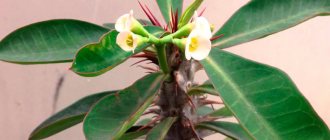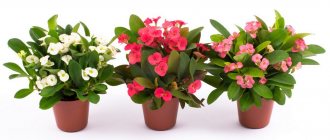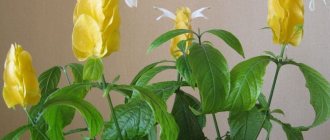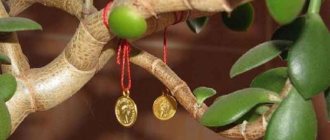The Euphorbia genus of the Euphorbia family includes approximately 2 thousand species of annual and perennial herbs, succulents resembling cacti, shrubs, subshrubs, and trees.
Author of the article
Maxim Sverchkov
Professional biologist and breeder with extensive experience and experience.
The appearance of these plants is diverse; a common feature of all is the poisonous juice that is released when damaged. Some species are used in herbal medicine, others are bred as ornamental.
Description of euphorbia
The height of milkweed is from 2 cm to 2 meters. The stems are straight, thin or fleshy, in the form of columns and triangles, with wide or thin leaves, often with spines.
Natural environment tropics of Asia, Africa, Madagascar. The juice of all types is hot, has a pungent aroma, is poisonous, contains sugar, rubber, essential oil, resin, euphorin, which burns mucous membranes and skin.
Most species of milkweed have inconspicuous flowers (there is no perianth, stamens and single pistils). The fruits of the capsule “shoot” euphorbia seeds, which quickly germinate.
Succulents are used in their homeland when planting hedges around residential buildings. Many varieties of milkweed are weeds, in Russia it is Euphorbia sungazer.
How to propagate milkweed?
Propagation of milkweed is available in three ways.
Sowing seeds
In order to obtain milkweed seeds yourself, you must have at least one female and one male. In this case, the crop can propagate by self-seeding and makes it possible to collect suitable seed material. Sowing seeds is carried out in open ground; this can be done in winter or spring. Milkweed seeds have a rough shell and require scarification (physical destruction of the hard outer shell that prevents the embryo from germinating). To do this, the fruits are carefully ground with fine sandpaper in such a way as to destroy the upper shell, but not damage the embryonic kernel. To get early flowering in the open ground, milkweed seeds can be planted at home in a flower pot in the winter, and taken out into the garden in the spring with the onset of stable warmth.
Cuttings
Young shoots are used as cuttings, which are cut into pieces at least 10 cm long. For thick shoots, the sections need to be dried for 24 hours; you can sprinkle them with a root formation stimulator, and then place them in a moist substrate. To speed up rooting, the cuttings are covered with bags or transparent plastic containers. Rooting will take about a month, after which the cuttings are transplanted by transshipment to a permanent place.
Dividing the bush
This method is not suitable for all species, but only for well-branched varieties of milkweed. The algorithm of action is usual. The bush is dug out of the ground and divided into several sections, preserving several above-ground buds and part of the root system. Specimens not younger than three years of age must be divided.
In addition, many species of milkweed produce numerous shoots, which are excellent propagation material.
Types of euphorbia for indoor floriculture
- white-veined;
- comb;
- Millie (brilliant);
- triangular;
- poinsettia (the most beautiful);
- large-horned;
- thirukalli;
- swollen;
- bordered.
Euphorbia comb
Comb milkweed is very similar to white-veined milkweed, so these species are often confused. The bright green stem is straight or twisted in a spiral, the shoots have 5 sides, longitudinally located thorns can reach a length of 3 cm.
The oval glossy leaves have an oblong shape, the reverse side is lighter, reflecting light. Inflorescences on short greenish-red peduncles, bracts white, less often pink, flowers greenish-yellow
Euphorbia Mile
Euphorbia Mila (brilliant) is a highly branched shrub, the branches grow up to a meter, they are widely spread and curved. This plant is often called blackthorn. The stem is round, the thorns are strong.
In the axils of the growing segments of the shoots there are inflorescences-umbrellas, containing 2-4 inconspicuous flowers, surrounded by bright bracts. On a southern windowsill, this species blooms almost without interruption, as it prefers to grow directly in the sun, sometimes shedding its leaves in winter.
In another article we described a plant called Agave.
Euphorbia domestica
Euphorbia domestic poinsettia (the most beautiful) has large ovoid leaves (up to 15 cm), reddish cuttings. Umbrella inflorescences are located at the tops.
The flowers are small, inconspicuous; bright bracts provide decoration (usually red, cream or orange in hybrid varieties). The flowering period (December, January) determines another name for the species: Christmas star.
Euphorbia tirucalli
Euphorbia tirucalli (rubber) is a branched bush with a thin, very dark stem, small leaves located at the top. You can grow a tree indoors that does not bloom. Propagated by cuttings, the juice is especially poisonous.
Euphorbia bighorn
Euphorbia is a large-horned succulent whose appearance is almost no different from a cactus. The fleshy triangular stem has 3 curved, unequal ribs, large leaves, and spines on the plates.
The inflorescences are corymbose, the yellow flowers are inconspicuous, the fruits are coral. Cuttings are used for propagation. In summer it is watered moderately, in winter almost no moisture is required.
Swollen Euphorbia
Many people perceive swollen milkweed as a cactus with eight or ten ribs. The inflorescence is formed at the tops of the shoots, the fruits develop in the presence of 2 plants of different sexes.
Polyhedral spurge
The multifaceted spurge bush is a succulent, the stem is round, fleshy, ribbed. On the ribs there are purple, almost black, spines and warty growths of brown color. Branches from the base. The inflorescences are corymbose, the bracts are red, the yellow flowers are small.
Bordered Euphorbia
Edged spurge is a herb, height from 40 to 80 cm, popular names: “Bride”, “Summer Snow”. The bush is branched, the foliage is round or pointed, with a white border. Small flowers at the tops of the shoots.
Planting milkweed
Before you begin planting or any other work with this plant, you must take safety measures in view of the toxicity of its milky sap. Euphorbia is distinguished by its low maintenance and ease of planting. If you plant it in open ground, you must choose an area open to sunlight or a slightly shaded area, with the exception of bordered milkweed. This variety prefers to grow in the shade, since bright sunlight is detrimental to the decorativeness of its foliage.
The plant does not tolerate excess moisture and acidity of the soil, so for planting it you need to choose a dry place, and acidified soils should be limed. The arrangement of high drainage, especially in places with clayey, poorly permeable soil, is mandatory.
Growing Euphorbia
Euphorbia alba is the most popular for growing at home. The trunk, thickened towards the top, consists of 4, 5 ribs, along the edges of which stipules are located.
The cuttings are reddish, the color of the foliage is emerald, the white veins are pronounced. Each fallen leaf leaves a mark on the trunk.
New leaves grow only at the top; an adult plant resembles a strange palm tree (see this euphorbia in the photo). It happens that in the fall the leaves fall, and in the spring new ones grow.
The flowers are inconspicuous (sessile inflorescences, without bright bracts, almost transparent petals). This species grows quickly even without care and reproduces independently.
The seeds germinate in potted plants located nearby. To plant new plants, you can also use the lateral shoots growing on the stem. If it is necessary to grow a lot of new white-veined euphorbia, the seeds are collected, lightly pressed into the soil, and covered with film.
Watering euphorbia
For irrigation, water at room temperature is used. Fertilizers produced for succulents are applied monthly. In winter, the plant is watered after the soil is completely dry; the temperature cannot be too low. The air of a city apartment is not a hindrance even in the absence of spraying.
The soil
The soil mixture is made from leaf humus, peat, sifted and washed sand in equal parts. The container is not deep, wide (the roots of this species are weak). If a large plant is being transplanted, pebbles are placed under the soil to ensure stability.
Temperature
Temperature in cold weather up to +15°C. In summer it is watered abundantly; regular spraying is advisable. For monthly feeding, cactus formulations are used.
Transfer
An annual transplant of Euphorbia Mil is not required. The soil consists of turf, preferably clay, humus, sifted sand, and leaf humus. For propagation, the bush is divided or cuttings are germinated. On new plants, the tips of the stems are pinched.
The triangular euphorbia flower is almost no different in appearance from a branched cactus. The triangular stem has straight spines, the foliage is oval and bright. In fertile soil this species grows very quickly. It is imperative to pinch the top of the head to limit height growth. The pot can be placed not only in the light, but also in partial shade.
During growth, abundant watering and monthly fertilizing are required. If this plant is not watered for several days, it will not die, it will only shed its foliage, which quickly grows back after watering. In winter, humidity is limited.
Also take a look at the article about Episcia.
Diseases and pests
Euphorbia is resistant to diseases, and insects are not interested in it because of the poisonous juice. All ailments that threaten a flower arise from deficiencies in maintenance. Main alarming symptoms and their possible causes:
- The leaves in the crown have wilted and drooped—the roots are overflowing.
- Single brown spots on the trunk, discoloration of leaves - sunburn.
- The leaves all over the crown turn yellow in the middle of the growing season - the soil is waterlogged or there is a draft.
- Multiple brown spots on the central shoot indicate stagnant water that has caused rot.
- Yellowing and dropping the lower leaves in the fall is a possible way for milkweed to prepare for winter.
Infections and fungal diseases mainly affect weakened bushes, but if this happens, it is worth using special fungicides to treat the entire plant.
Another beautiful succulent is Haworthia striped. Let's talk about him separately.
Each species may have different reactions to poor care. The good thing about the genus of euphorbia is that it is enough to notice the dissatisfaction of the plant in time and correct the shortcomings, and the bush resumes growth and is restored.
The patient milkweed flower can become a bright decoration for a room or windowsill, even for a novice gardener. The main rule when growing this overseas guest is to take care, but not to overdo it. In average conditions of an ordinary apartment, it can live for many years without replanting or special fertilizers, and the ease of propagation allows you to get as many young plants as you like from one bush.
Reproduction of euphorbia
Propagated by cuttings, new plants are planted in wide, not deep pots with standard soil mixture. Stability is provided by pebbles placed under the soil.
The pot with poinsettia should be placed on a well-lit windowsill, but in summer it is advisable to avoid the rays of the sun, in winter cold drafts, and close proximity to heating devices. Optimum temperature +16-20°C, minimum +12°C.
Watering is moderate all year round. After the flowers fall, rest is required with almost no watering for one and a half or even two months.
After the leaves fall, pruning is carried out, as a result of which the length of the shoots is no more than 15 cm. No more than 5 shoots are left, this amount is enough to form a lush crown. If necessary, the tops of cut shoots are used for propagation.
The plant is moved to a cool place until May, then it is watered abundantly and transplanted into a larger pot, at the same time fertilizers with potassium are applied.
In order for poinsettias to bloom on time, preparation is required. Starting in September, the daylight hours are artificially shortened (the milkweed is covered for several hours). Otherwise, the buds will begin to bloom in late winter.
Cuttings cut for propagation have at least 5 internodes. Immediately after cutting, the lower leaves are removed and the shoots are placed in warm water (the juice should not block the vessels). Germination requires moist peat mixed with sand.
In the presence of a filmy covering and a temperature of +24°C, the roots grow quickly. New plants are planted and the tops are pinched after they begin to grow.
From Euphorbia poinsettia you can grow a relatively large bush or tree at home, if you do not prune it at the end of flowering, transplant it into a larger container and gradually form a crown.
Reproduction of euphorbia is only by seed. This species loves light and does not suffer from drought, so watering is moderate even in summer.
Recommendations
- Book, E. (2017). Euphorbia canarian
.
IUCN Red List of Threatened Species 2022: e.T79727248A79727254. https://dx.doi.org/10.2305/IUCN.UK.2017-3.RLTS.T79727248A79727254.en. Uploaded on October 10, 2022
. - ^ a b
"
Euphorium canarian
".
Germplasm Resources Information Network (GRIN)
. Agricultural Research Service (ARS), United States Department of Agriculture (USDA). Retrieved 2008-03-22. - International index of plant names. "full name = Euphorbia canariasis
." Retrieved 2008-03-22. - Wijnands, D. O. (1983). "Europe shellfish." Botany of the Commelenes: taxonomic, nomenclatural and historical
. CRC Press. ISBN 978-90-6191-262-0. Retrieved 2008-03-22. - Decandall, A. (1837). " Euphorium canarian
".
Plantarum historia succulentarum = History of grass plants
. Retrieved 2008-03-22. - Barbara J. Collins, Ph.D. (2007-08-09). "Photos of the succulent Euphorbia canariensis 4744." Photos of succulents
. California Lutheran University. Retrieved 2008-03-23. - Bramwell, David and Bramwell, Zoe (2001). Wildflowers of the Canary Islands
(2nd ed.). Madrid: Rueda. p. 206. ISBN 978-84-7207-129-2. - ^ a b
"Flora of the Canary Islands - Arid Habitat". Archived from the original on 2008-03-06. Retrieved 2008-03-02. - Ley 7/1991, from 30 August, de símbolos de la naturaleza para las Islas Canarias
- Thijs de Graaf. "Spurge". spurge
. Retrieved 2008-03-23. - Marco, JA, J; Sanz Cervera, J. F.; Yuste, A. (June 1997). "Ingenane and lathyrane diterpenes from the latex of Euphorbia canariensis". Phytochemistry-Oxford
.
45
(3):563–570. Doi:10.1016/S0031-9422 (97) 00018-6. Archived from the original on 2008-08-07. Retrieved 2008-03-23. - ^ a b
University of Connecticut (March 18, 2008).
" Euphorbia canarian
L. "
Data on joining the EEB greenhouse
. Ecology and evolutionary biology of Greenhouses. Retrieved 2008-03-23. External link in | publisher = (help)
Features of euphorbia content
Most species love the sun; shade is required in hot weather. You shouldn’t be overzealous with watering; less is better than too much.
The exception is species with foliage, which require abundant watering in summer. Fertilizers are selected. Taking into account the characteristics of the species. The temperature during winter dormancy is not lower than +16°C.
For milkweeds, containers with a drainage layer and a hole in the bottom are selected. The soil mixture is the same for all types. Young plants must be replanted annually.
The main method of propagation is cuttings, for spherical species - seeds. Cuttings are harvested during spring pruning or summer. Be sure to immerse in water to get rid of excess juice. For rooting, a sand-peat mixture is used.
An important part of caring for euphorbia is the fight against fungus and insects. The main disease is fungal and manifests itself as rotting of the trunk and roots.
If the root system is damaged, the spurge is removed from the container, the roots are cut off, and the euphorbia is transplanted into another container with a new soil mixture. When the trunk rots, only the tip takes root.
If there is a whitish coating on the foliage (powdery mildew), the plant is treated with a fungicide. It is advisable to reduce watering and move the spurge to a more illuminated place.
A thin thread on the foliage indicates the appearance of a spider mite. The plant is sprayed with a soap solution; in case of severe damage, a systemic insecticide is required.
Euphorbias do not get sick if the rules of planting and care are followed:
- the substrate is too loose or too heavy;
- there is no good lighting, moderate watering, winter coolness;
- the root collar is covered with earth.
If spurge is constantly in contact with damp soil, the root collar becomes like a plug. It should be covered not with soil, but with gravel. Most species are succulents, so they store water. In summer, the soil can be completely dry for up to 3 days, in winter for more than a week.
During dormancy, additional lighting and watering are not required. When the room temperature is above +15°C, spurge grows. If there is not enough light, the stems become bent.
Caring for them is the same
Arrange spurge
It is best to have a window facing western or eastern directions.
Near a south window, the plant will need shading on hot summer days.
Excessive sun can cause leaves to drop. With all this, among the euphorbias there are species that agree to a south window without any concessions. In summer, euphorbia will not give up dacha or balcony life in the fresh air.
Most milkweeds - if you noticed - come from Africa, and therefore respect warmth
.
In summer, the optimal temperature for keeping will be 22 - 26 degrees.
The rest of the time, you shouldn’t freeze either. Temperature maximum – 12 degrees. And as always, there will be those who can withstand a short-term drop to 5 Celsius. If in winter you cannot provide coolness and are forced to steam together at 25–28 degrees, at least give the plant more light. Will thank you.
When watering milkweed, the main thing, again, is to remember Africa. Excessive watering is a direct road to the cemetery.
Watering the spurges
soft, warm water as the top layer of soil dries. Species with large leaves (for example, white-veined euphorbia) should not be overdried - this can cause the leaves to fall off.
However, milkweeds do not take offense at forgetful owners who love half-dead plants in their interiors - they calmly tolerate drying out of the substrate.
Euphorbias that look like cacti (for example, Euphorbia obesum) are watered sparingly in the summer, and even less often in the winter.
It has been scientifically proven that the humidity of the surrounding air
, milkweeds don't care.
However, milkweeds with lush foliage nod gratefully in response if this same foliage is regularly washed or wiped with a damp cloth.
The age-old question “ to feed or not to feed”
» should not stand in front of milkweed lovers. Definitely feed during the period of active growth (read: spring and summer). They like fertilizer for cacti in the doses described in detail on the bottles with this same fertilizer.
Replant spurge
- that’s still entertainment. Especially some kind of tirucalli or triangular spurge. The main thing is to take thicker mittens.
Euphorbias are replanted in the spring - before active growth begins. Young plants are replanted annually, adults - by inspiration once every 2-3 years.
It is better to prepare the soil for plants with love. You will need universal soil (in any flower shop), peat (there is plenty of it in the direction of the Moscow Highway, look for the smoke spots and the characteristic smell of smoke around), sand (haven’t all the sandboxes in the yards been exhausted yet?), brick chips (I don’t even know where send you). If you find charcoal nearby (hello barbecue lovers!), take it too - it will do. Next you will have to mix everything thoroughly. Hands ((c), my daughter).
Good drainage is poured into the prepared pot (don’t take it much larger than before - no need) - everything that is in the house is suitable: from ordinary expanded clay, broken dishes, pieces of foam packaging from household appliances to nut shells and eggs.
In general, there are rumors that the plant is suitable for hydroponics. I don’t believe it ((c), Stanislavsky) - they are already succulents. Although…
Reproduce
Euphorbia the good old ways: cuttings, dividing the bush, seeds
(and why has no one come up with anything new so far?).
White-veined spurge is best propagated by seeds. Without particularly caring about his offspring, he shoots them around him. Therefore, keep your eyes open for him - you’ll just gape as these foundlings will grow in all the pots.
Euphorbias that have any branches (almost all except M. plump) can be propagated by stem cuttings. And you can safely take cuttings from columnar plants that form numerous shoots. Fresh “cuts” must be dried for 24 hours, allowing the milky juice to drain. Then planted in a light soil mixture.
Bushy milkweeds—like M. milia—can be divided.
For its kindness and beauty (well, not for its poisonous juice!) this plant is almost not to the taste of any reptiles. Only aphids and the completely crazy scale insect are tolerant to them. Control measures are here.
external reference
- Media related to Euphorbia canariasis at Wikimedia Commons
- Decandall, A. (1837). "Illustration of Euphorbia canariasis
."
Plantarum historia succulentarum = History of grass plants
. Retrieved 2008-03-22.
| Taxon identifiers |
|
Benefit
The culture is very common in folk medicine. Using parts of the plant, decoctions and tinctures are made , which are beneficial in the treatment of many diseases.
Euphorbia juice is a diaphoretic, diuretic, analgesic and anti-inflammatory agent.
Among them it is worth highlighting:
- Skin diseases : burns, ulcers, warts, lichen;
- Haemorrhoids;
- Constipation;
- Stomach diseases , including gastritis;
- Diseases of the genitourinary system , including cystitis;
- Tumor formations : benign and malignant;
- Colds ;
- Tuberculosis;
- Bronchial asthma;
- Female gynecological diseases .
Harm
There are a number of contraindications:
- Pregnancy and lactation;
- Childhood ; _
- Allergy to the plant and its parts, including milky sap;
- Serious lung and heart diseases.
An overdose of milkweed decoction or infusion can cause vomiting and diarrhea with blood.
For treatment, they use the milky juice that is secreted by the plant, the root (the muzhik root or Pallas's milkweed root is especially popular). Alcohol-based decoctions and tinctures are made from the leaves and roots . Decoctions and tinctures from the flowers of the plant are also actively used.
Euphorbia is also used to make honey because it is very attractive to bees. Milkweed honey is effective for treating stomach ulcers, gastritis, colds, insomnia and neuroses.
Thus, spurge is a plant distributed throughout the world. There are more than 2000 species in the genus. Many of them are actively used in floriculture and landscape design. The culture is very popular in the treatment of many diseases. Moreover, all types contain poisonous juice that is dangerous to human and animal health . Therefore, when preparing traditional medicine recipes, you need to be extremely careful and act only on the advice of doctors.
general information
Garden spurge most often refers to Euphorbia multiflora. This is a spherical shrub with a diameter of 50 cm to 1.5 m, depending on the variety. Among them there are annual and perennial varieties.
Milkweed has interesting leaf colors. They can be not only green, but also bluish or gray. Greenish-yellow flowers, at first glance, blend into the background, but become brighter as they bloom. Moreover, there are a lot of them, because every young shoot ends in an inflorescence.
Euphorbia leaves can be elongated, curled, oval, wavy - whatever. Basically, in size they reach a maximum of 8 cm. Leafy flowering shoots look like small individual bouquets.
Photo: greenmebrasil.com











